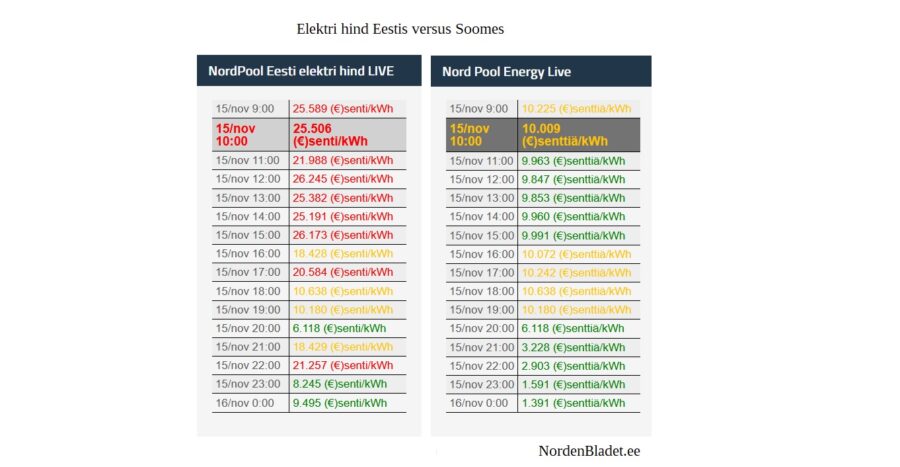NordenBladet – People have received their first enormous electricity bills and those who did not yet observe the power prices have carefully started checking the electricity prices and have limited or even completely avoided electricity consumption during the expensive hours. If you are not willing to lose all your salary due to the rising prices of electricity, then the daily power prices should be calculated and you should plan doing laundry, using the oven for several hours or having the floor heating turned on during the more favourable hours, in order to consume electricity in a smart way.
The following is a major and thorough insight – all that you might like to know about power prices and electricity consumption!
1. HOW MUCH DOES ELECTRICITY COST right now in real time? How much does electricity cost today and tomorrow? How do I know when electricity prices are good and when it is expensive?
NordenBladet.fi (Finland’s power prices) and NordenBladet.ee (Estonia’s power prices) hour by hour electricity price tables (electricity price guidelines) give you easy and clear information about electricity market prices (stock exchange of the moment). Simple, intelligible and convenient info about all day’s hour by hour electricity price in a graph showing the current electricity price.
Electricity prices are displayed on NordenBladet home pages sitewide, in the right hand side of the page, in a table. You can look up the exact electricity price from one full hour to the next.
2. How to use NordenBladet’s electricity guideline so that you would be able to consume less power and thus receive a smaller bill by the end of the month?
For a start, check the general provisions of the contract that you have with the service provider and understand exactly what type of conditions you have. In case you have an hour-based stock exchange package then it is vital that you observe the power prices!
Electricity price guidelines can be read as the traffic lights:
? Red – expensive price zone, i.e the day’s highest prices (20-… euro cents kWh) (In order to save money, try using less electricity during this period of time!)
? Amber – average price zone (10-20 euro cents kWh)
? Green – the day’s best price zone (… -10 euro cents kWh). (If you wish to save money and economize, we recommend that you use power during the green time zone!)
(extra to the prices indicated, there will be + VAT, network price according to your network service provider and location of the domestic consumer’s zone, and excise tax)
Home owners and entrepreneurs that have a stock exchange package, are better off when daily observing today’s and tomorrow’s stock exchange price and completing the most power consuming procedures during the most favourable (green) time zone.
By observing the electricity prices you will receive a smaller electricity bill and will be able to save considerable sums (hundreds, in some case even thousands of euros)!
? NordenBladet LIVE electricity price table has been exactly adjusted to the local time (we are displaying Finland’s as well as Estonia’s prices) and it shows in kilowatt-hours the CURRENT POWER PRICE!

Easy, free and intelligible time-based price table for working days as well as weekends.With this Nordenbladet application we will be displaying the daily electricity price that you can easily observe from our website from a computer as well as from your smartphone. Great help every day! Many people who used NordenBladet’s electricity prices already last month, received half of the size of the electricity bills that they might otherwise have received!
3. HOW TO CONSUME LESS POWER and thus save money? What can I do to consume less electricity? I want my average electricity consumption to be less so that I could save electricity. How to limit the electricity costs?
a).Heat insulation
When your living space is not well insulated and your home does not maintain the warm temperature, this will bring forth greater energy consumption. You might consider a proper insulation for the basement, the window sills, and walls. Also during the dark time of the day, use window coverings to minimise the necessity of heating during cold weather. The quickest and cheapest way is to roll up and place a small blanket or a large towel on the window sill as a temporary „wind shield”.
b). Room temperatures
Should you need to heat the rooms directly or indirectly with electricity (geothermal heating / electric radiators), a great financial difference already comes from lowering the temperature just a few degrees. And again, switch the electricity on just during the good price time zone.
c). Review your lighting
About one fourth of the household’s energy costs is usually due to lighting! We recommend you to exchange all light bulbs/halogen lights for LED lamps. LED, i.e. light-emitting diodes is a semi-solid semiconductor that converts electric energy directly into light, as opposed to the light bulb where 95% of the bulb’s light is converted to heat. By using LED lamps/LED bulbs, you save electric energy up to 90% as compared to regular light bulbs!
The life cycle of a LED lamp is up to 50 000 hours which also means economizing on the maintenance side. Also check that the lights are not on without a purpose, in the rooms that are empty, switch the lights off.
d). using the washing machine
Set the program on the day’s best time zone, if necessary, use the machine at night in case the electricity prices are in the red zone (extra high) for long periods of time. Usually night time prices are two times better. Also, usually during the weekend the electricity prices are better. The drier consumes about 450 kWh a year. Drying the clothes on a laundry rack will help you save money.
e). Refrigerator and deep freeze
Quite a few households use more than one fridge and deep freeze. It is reasonable to place all things in one fridge and eliminate the other for winter time. Annually, the energy consumption of an older generation fridge reaches dozens of euros, which may turn out more expensive than the products that are kept in cold. When the temperatures sink and the weather is cold, you may just as well switch off the fridge in the garage or the shed for 24 hours, when the prices are extra high, and then switch them back on again.
f). See if you are at all using all the appliances
Plug off the appliances! When bringing home technology, be smart and choose the energy saving appliances. However… even though the domestic appliances are more and more energy efficient these days, the number of various appliances in homes is very high and thus our energy consumption keeps increasing. Studies have shown that more than one fourths of people keep their utensils on standby. This however means that each watt spent on standby regime brings along the cost of one euro a year. Plug off the utensils and the battery chargers that you are not using daily. The standby energy consumption of your utensils may make up as much as 10 percent of the household’s electricity bill.
4. HOW MUCH DO DIFFERENT UTENSILS consume power? Which home appliances consume most electricity? How much do home appliances /technology consume energy on an average?
The electric stove and oven consume the annual 23%, around 280 + 420 kWh. Considering the average one time consumption to be 1.4 kWh and considering that the stove is being used 300 and the oven 200 times a year, we get the annual energy consumption of 700 kWh. Glass ceramic stove generally consume less energy that metal top stoves with a heater.
Refrigerator – a ten-year-old refrigerator will annually consume 850 kWh electricity, at the same time, the new A+ fridges will use an annual 280 kWh. An average fridge will consume an annual 420 kWh. PS! The more ice gathers, the more grows the energy consumption!
Television – a TV-set will consume the annual 100 kWh. The newest A+++ class led-televisions consume one third less energy than the regular A class efficiency television set, and about 60% less than plasma televisions.
Dish washer – it consumes around 280 kWh annually. On an average, the dish washer can take 12 sets of dishes, using 1 kWh energy. When washing the same amount of dishes by hand, the heating of the water would take an average of 2,5 kWh energy. Therefore the dish washer takes 60% less energy when compared to washing by hand.
Washing machine – consumes about 260 kWh annually.
Tumble dryer – this consumes a lot of energy, an annual 450 kWh. Since it is largely a convenience device, it would be reasonable to give it up to save money. Older machines consume 4 kWh energy per working cycle, for 200 working cycles it will sum up the annual 800 kWh.
Computer – the most energy efficient is a laptop, it consumes 80% less energy than a personal computer. Even more efficient are tablets. The PC consumes the annual 500 kWh electricity, the laptop 60 kWh and the tablet only 3 kWh.
Other home appliances – from smaller home appliances the kettle, the iron, the microwave oven and the vacuum cleaner consume most power. Less power consuming are the coffee machine, blenders and food processors, blow dryers, ventilators, air cleaners. Heating water with an electric boiler makes up about 20% of the annual energy consumption.
Observing the current stock exchange power prices, economizing and awareness of electricity consumption, knowing how much your home technology consumes power, you may save hundreds of euros per month. In case you have an hour-based stock-exchange electricity package, start observing the power prices already today!
